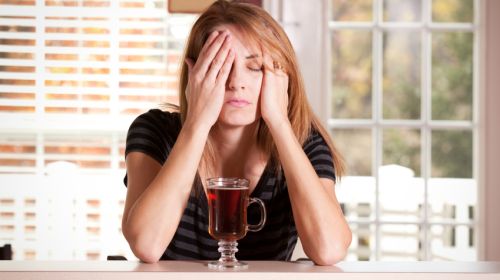Migraines – it's more than a headache: nausea is almost always one of the accompanying symptoms, often also vomiting. Hypersensitivity to light and noise is also one of them. In children and the elderly, the symptoms may be slightly different than in all other age groups. Everything about the symptoms, accompanying symptoms, harbingers and aura symptoms in migraines.
- Strong, throbbing headaches are the typical symptom of migraines.
- © iStock.com/70487
The most typical symptom of migraines is moderate to severe headache that occurs as an attack and lasts between four and 72 hours. They are often one-sided and are described as throbbing, pounding, stabbing or pulsating. The headaches start weakly – mostly from the forehead and back of the eyes, sometimes also from the ear – and get worse quickly. During a migraine attack, the pain can travel from one side of the head to the other. Any movement, including coughing or sneezing, increases the pain. This is an important differentiating criterion, for example, from tension headache, which can subside through exercise in the fresh air.
At a glance:
Concomitant symptoms of migraines
The headache is typically accompanied by other symptoms:
Those affected feel the need to withdraw to a darkened room, to isolate themselves completely or to sleep.
The migraine attack is preceded by an aura in ten to 15 percent of those affected. These are neurological symptoms that occur immediately before the onset of the headache and last for up to 60 minutes. Usually these are visual symptoms such as flashes of light, stripes or points that are perceived. However, speech disorders or abnormal sensations such as tingling or numbness can occur, and in rare cases even symptoms of paralysis.
Symptoms as the harbingers of the migraine attack
Diffuse symptoms such as hunger for sweets, tiredness, irritability, difficulty concentrating, yawning or paleness can occur up to 48 hours before a migraine attack. Further possible harbingers can be stiff neck, sensitivity to light or noise, nausea or blurred vision. A migraine diary can help to identify the individual symptoms as harbingers of migraines and thus to counter an attack early with suitable treatment.
When children have migraines, symptoms are slightly different from adults. The attacks are usually shorter, and the ghost is often over after two hours. Other accompanying symptoms can also occur. These include an accelerated pulse, paleness or reddening of the skin, thirst, appetite, urination, or tiredness. An increased body temperature can also be a symptom of migraines. The migraine headache, which usually occurs on one side in adults, is often bilateral in children, typically in the forehead area. However, especially in children, the headache often does not occur, the migraines are then mainly noticeable through regular attacks of dizziness with nausea and vomiting, diarrhea and abdominal pain.
Migraine Symptoms in Children and Seniors
When it comes to the question of how often migraine patients are affected by aura symptoms in childhood, various information can be found in the specialist literature, ranging from nine to 50 percent. One thing is certain: even children can get an aura as an immediate precursor to migraines, and visual disturbances are the most common here, as in adults.
In old people, migraine attacks become less frequent and headaches are less pronounced. Often they are completely eliminated. Instead, aura symptoms are more common in seniors with migraines. It is not uncommon for them to be the only migraine symptom, which can lead the attending physician on the wrong track: "If the aura occurs in isolation without a headache, there is a risk that the diagnosis of epilepsy or even a stroke will be made, even though it is actually a migraine is available ", had private lecturer Dr. Stefanie Förderreuther from the Neurological Clinic at the Inner City Clinic in Munich reported two years ago at the 15th annual congress of the International Headache Society (IHS) in Berlin.
Regression phase
When the symptoms of a migraine attack slowly resolve, most people feel tired and exhausted. The body now needs rest and time until the symptoms have completely disappeared. In some patients, the tapering off of migraine symptoms is accompanied by an increased need to urinate. It can take 12 to 24 hours until you are completely fit again after the migraine attack.


